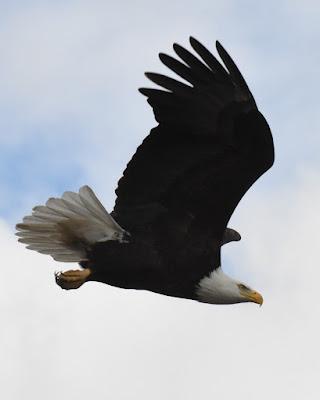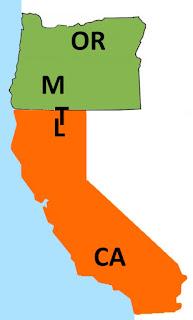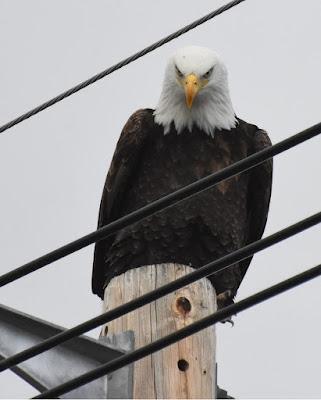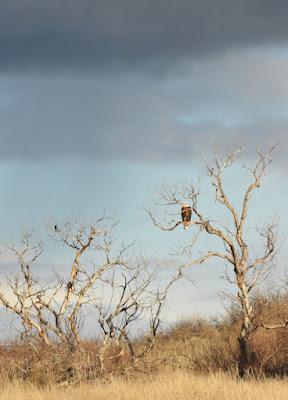
Bald Eagle, Tule Lake National Wildlife Refuge, California
My friend Caroline Hatton, a children’s writer and frequent contributor to this blog, took these photos in Northern California and Southern Oregon in February 2024.

Tule Lake (T), Lava Beds National Monument (L), CA; Mount Thielsen (M), OR
Ever since I read that the Tule Lake area in Northern California is where to look for “the largest number of wintering Bald eagles in the contiguous U.S.,” it’s been on my Pacific Northwest bucket list. Bald eagle numbers peak in mid-February, some years reaching above one thousand. By late March, the eagles have left on their journey north.
In February 2023, temperatures below freezing, ice, and snow made driving conditions potentially treacherous. I chose to stay safe at home in Eugene. A year later, nighttime temperatures barely dipped below freezing. It was time to go!
The Tule LakeNational Wildlife Refuge is one of six Klamath Basin Refuges which are the last remnants of once-immense wetlands, shrunken by agricultural development. The refuges are a rest and feed stop for waterfowl migrating along the Pacific Flyway. Winter waterfowl are bald eagle food.
At the website for this wildlife refuge, a term that makes it sound like a safe haven for animals, I was surprised to see “Hunting” under “Visitor Activities.” When I looked up the 2024 hunting seasons, on different dates for ducks, scaups (diving duck species), or Canada geese, I found that all hunting had ended in January. I felt reassured that visiting in February should be safe from stray bullets.
Upon arrival, we stopped at the Klamath Basin National Wildlife Refuge Visitor Center at Tule Lake. The building contains excellent displays of taxidermy ducks, geese, eagles, and other birds commonly seen at the refuge, a library of relevant nature books, and a children’s play area with toys. The Ranger said, “There must be a hundred Bald Eagles out there right now,” sparking bright hope that we would see some. During the day, they look for water birds to eat. At night, they roost in treesy areas (such as the nearby Bear Valley National Wildlife Refuge, closed to the public). At dawn and dusk, they fly out and fly back, commuting to their day job.
The Tule Lake Refuge includes wetlands, some of which are farmlands seasonally flooded by irrigation. A network of dirt roads includes a 9-mile Auto Tour Route that begins four miles south of the Visitor Center and an array of straight roads on top of dikes, some with a power line running alongside.

Bald Eagle.
We drove off, scanning sky and land and tops of power poles for photogenic birds. One bald eagle stared us down.

Bald eagle in tree.
To increase our chances of sightings, we chose to move around the vast area rather than sit still for hours at roadside spots or Wildlife Overlooks. Nature gifted us with dazzling visions: two more bald eagles, moody skies in turmoil, rain drawing dark curtains on the horizon one minute and washing over us the next, brilliant rainbows flashing in and out of existence…

White pelicans in front of the Peninsula rock formation.
We saw lots of duck species, coots, white pelicans, tundra swans, and sandhill cranes. A distant, gigantic, solid-looking white area contrasting with pale blue lake water turned out to be a clumped flock of perhaps a thousand birds!
For dinner at Señor Tequila in the town of Tulelake (one word), we tasted chicken specialties with decadent, Land O’Lakes secret cheese sauce (imagine chicken Stroganoff, especially since my selection contained added sour cream)… I ate a little of it and carried away the rest to eat for another meal.
When we checked in at the Winema Historic Lodge on the edge of the refuge, the owner, Loyal Taylor, whose awesome first name I had never encountered before, generously shared stories about the bald eagles and barn owls who are his neighbors. Breathtaking photos of some of them hang in the lodge dining room.
Everywhere we went on that February Wednesday, we were the only visitors there. That night, the temperature dropped around freezing. The wall heater in our room rumbled loudly on and off, so we turned it off and piled extra blankets on the bed. Even though I put on thermal clothing, I dreamed that I was back in the frigid Himalayas, in an unheated tea house room!
To be continued in next week's post.
All text and photos, copyright Caroline Arnold. www.theintrepidtourist.blogspot.com
